Concept of Static Electricity
The Concept of Static Electricity
Explain the concept of static electricity
Static electricity refers to the electric charges stored on a conductor.
The Orign of Charges
Explain the origin of charges
When
a plastic pen is rubbed with a cloth, it acquires the property of
attracting small bits of paper or light objects. In this case, the
plastic pen is said to be electrified.
a plastic pen is rubbed with a cloth, it acquires the property of
attracting small bits of paper or light objects. In this case, the
plastic pen is said to be electrified.
Electrification
by rubbing was observed a long time ago by ancient Greeks. After the
discovery of electricity, things were grouped into two groups, electrics
and non-electrics. Electrics refer to things which are readily
electrified while non-electrics are reverse of the former.
by rubbing was observed a long time ago by ancient Greeks. After the
discovery of electricity, things were grouped into two groups, electrics
and non-electrics. Electrics refer to things which are readily
electrified while non-electrics are reverse of the former.
The two Types of Charges
Identify the two types of charges
There are two types of charge:
- positive charge
- negative charge
Identification of charge
Suspend
a polythene rod A rubbed with fur. Bring another polythene rod B rubbed
with fur up to the rod A. Take a plastic rod and rub it with fur. Bring
the plastic rod to up to the suspended rod A. Repeat the exercise with
acetate and glass rod rubbed with silk cloth.
a polythene rod A rubbed with fur. Bring another polythene rod B rubbed
with fur up to the rod A. Take a plastic rod and rub it with fur. Bring
the plastic rod to up to the suspended rod A. Repeat the exercise with
acetate and glass rod rubbed with silk cloth.
Observation
An
electrified polythene rod repels another electrified polythene rod. An
acetate rod rubbed with silk repels another acetate rod rubbed with silk
cloth but it attracts a plastic rod rubbed with fur.
electrified polythene rod repels another electrified polythene rod. An
acetate rod rubbed with silk repels another acetate rod rubbed with silk
cloth but it attracts a plastic rod rubbed with fur.
Explanation
Polythene
and plastic when rubbed with fur becomes electrified with the same kind
of electricity known as negative electricity (charge).
and plastic when rubbed with fur becomes electrified with the same kind
of electricity known as negative electricity (charge).
Acetate
and glass when rubbed with silk cloth becomes electrified with the same
kind of electricity called positive electricity(charge).
and glass when rubbed with silk cloth becomes electrified with the same
kind of electricity called positive electricity(charge).
Charging is the process of electrifying a body.
A
positively charged body carries positive charges and a negatively
charged body carries negative charges.The symbols used for positive and
negative charges are + and – respectively.
positively charged body carries positive charges and a negatively
charged body carries negative charges.The symbols used for positive and
negative charges are + and – respectively.
The Fundamental Law of Static Electricity
State the fundamental law of static electricity
The Fundamental law of electrostatic charges states that:“Like charges repel each other while unlike charges attract each other”
Charging Bodies Using Different Methods
Charge bodies using different methods
In
order to understand the process of charging we have to understand the
structure of bodies or things. All bodies are made up of extremely
small, indestructible bits of matter called atoms.
order to understand the process of charging we have to understand the
structure of bodies or things. All bodies are made up of extremely
small, indestructible bits of matter called atoms.
An
atom consists of a nucleus surrounded by electrons. The nucleus
consists of proton and neutron.The protons are positively charged while
electrons are negatively charged and the neutrons are neutral.
atom consists of a nucleus surrounded by electrons. The nucleus
consists of proton and neutron.The protons are positively charged while
electrons are negatively charged and the neutrons are neutral.
The whole atom is electrically neutral because it contain equal number of protons and electrons.
The following are the methods of charging;
- Rubbing
- Induction
- Contact
Charging by rubbing
A
polythene rod rubbed with fur becomes negatively charged.Rubbing
results in the transfer of electrons from fur to the polythene rod.
polythene rod rubbed with fur becomes negatively charged.Rubbing
results in the transfer of electrons from fur to the polythene rod.
Fur
becomes positively charged because some of its electrons are
transferred to the polythene rod.The polythene gains excess electrons
and hence it becomes negatively charged.
becomes positively charged because some of its electrons are
transferred to the polythene rod.The polythene gains excess electrons
and hence it becomes negatively charged.
Note:It is only the electrons in matter which can be transferred by rubbing.
Charging by induction
A charged polythene rod is held near uncharged copper rod suspended from a cotton thread.
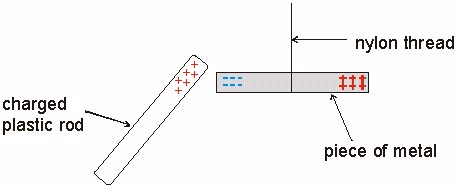
The
electrons of the copper rod are repelled by the negatively charged
polythene rod.Hence the electrons move to the far side of the copper
leaving behind a net positive charge on the side facing the polythene
rod.
electrons of the copper rod are repelled by the negatively charged
polythene rod.Hence the electrons move to the far side of the copper
leaving behind a net positive charge on the side facing the polythene
rod.
Touch
the copper rod with your finger when the charged rod is still in
position. The electrons from copper rod flow through your body to the
earth. Leaving it with a net positive charge. Remove the finger from the
copper rod and finally remove the charged polythene rod.
the copper rod with your finger when the charged rod is still in
position. The electrons from copper rod flow through your body to the
earth. Leaving it with a net positive charge. Remove the finger from the
copper rod and finally remove the charged polythene rod.
The
rod has therefore been positively charged by electrostatic
induction.The charges that appear on the copper rod are called induced
charges.
rod has therefore been positively charged by electrostatic
induction.The charges that appear on the copper rod are called induced
charges.
Charging by contact
A charged body (eg; positively charged metal can) is brought in contact with uncharged body B.
Detection of Charges
The Structure of a Gold-leaf Electroscope
Describe the structure of a gold-leaf electroscope
The instrument used to detect the presence of electric charges is called gold leaf electroscope. It consists of an insulated brass rod with two pieces of thin gold foil at one end and a brass cap at the other end.
When
the brass cap is touched with a charged object the leaves of the
electroscope spread out. This is because the charge on the object is
conducted through the brass cap and the brass rod to the leaves.
the brass cap is touched with a charged object the leaves of the
electroscope spread out. This is because the charge on the object is
conducted through the brass cap and the brass rod to the leaves.
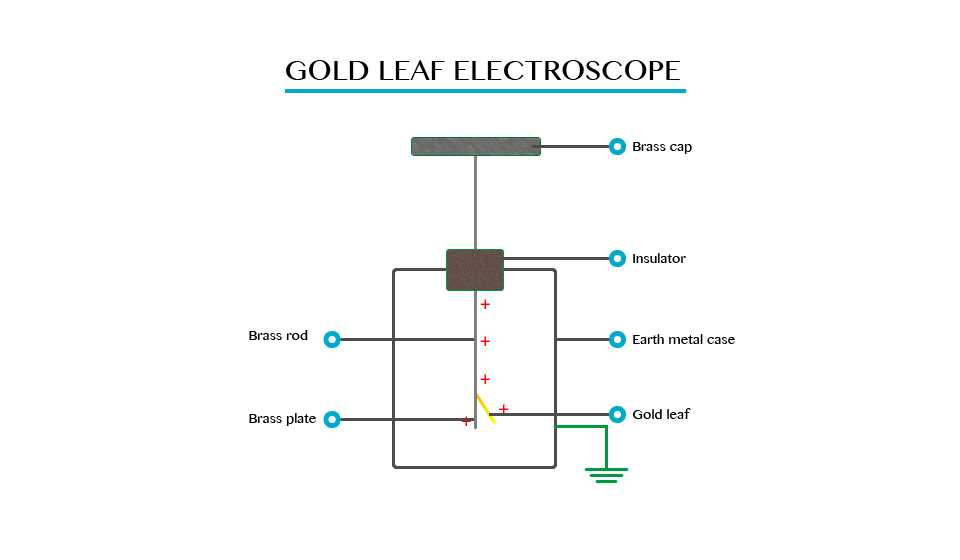
As they received the same kind of charge, the leaves repel each other and thus spread apart, this is charging by contact.
If
you touch the brass cap with your finger, the charge is transferred
through your body to the earth and the leaves of the electroscope then
collapse together.
you touch the brass cap with your finger, the charge is transferred
through your body to the earth and the leaves of the electroscope then
collapse together.
Function of an electroscope
- Testing for the sign of the charge on the body.
- Identifying the insulating properties of materials.
- Detecting the presence of charge on a body.
The Sign of Charges
Determine the sign of charges
The
true sign on a body has to be determined before use; the instrument
that can be used to determine the presence of charge is called an
electrophorus.
true sign on a body has to be determined before use; the instrument
that can be used to determine the presence of charge is called an
electrophorus.
An
electrophorus consists of a circular slab of insulating material
(polythene) together with a brass disc (conductor) on an insulating
handle.
electrophorus consists of a circular slab of insulating material
(polythene) together with a brass disc (conductor) on an insulating
handle.
An
electrophorus works by electrostatic insulation and hence can be used
to generate positive charges from single negative charges. The charge
produced on the insulating slab is negative. The top disc is then placed
on it. Since the surface is only in contact at relatively few points, a
positive charge is induced on the lower surface and corresponding
negative charge is produced on its top surface.
electrophorus works by electrostatic insulation and hence can be used
to generate positive charges from single negative charges. The charge
produced on the insulating slab is negative. The top disc is then placed
on it. Since the surface is only in contact at relatively few points, a
positive charge is induced on the lower surface and corresponding
negative charge is produced on its top surface.
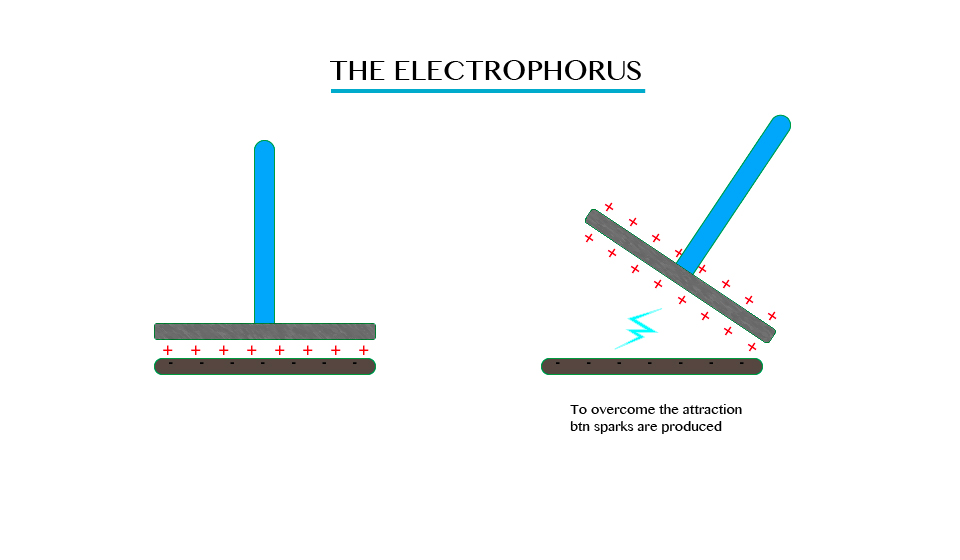
The
top of the upper disc is then touched briefly using a finger, hereby
carrying away the negative charge to the earth; this is called EARTHING.
top of the upper disc is then touched briefly using a finger, hereby
carrying away the negative charge to the earth; this is called EARTHING.
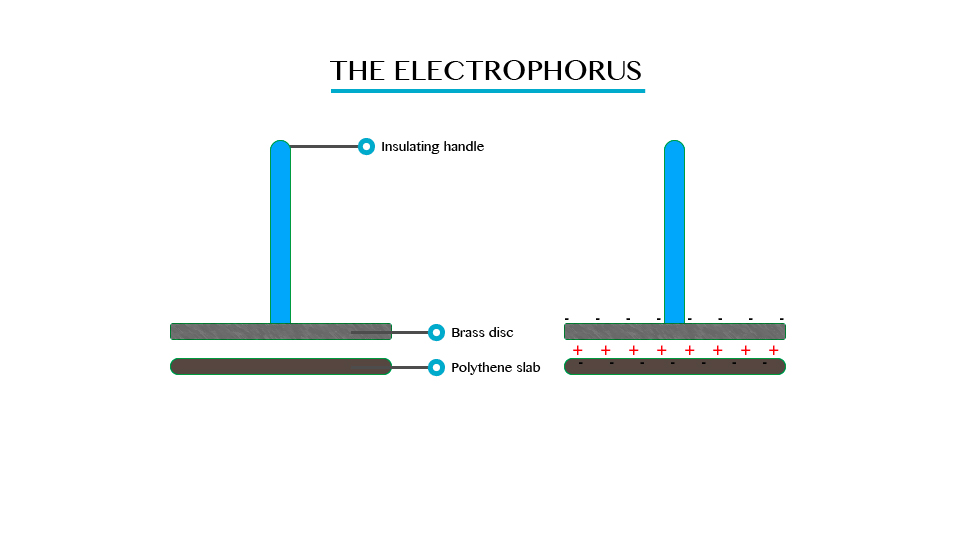
Steps of Charging and Discharging of a Gold-leaf Electroscope
Identify steps of charging and discharging of a gold-leaf electroscope
The
polythene slab is charged negative by rubbing it with fur. The brass
disc is then placed on top of the slab so that the two charges become
induced onto respective materials.
polythene slab is charged negative by rubbing it with fur. The brass
disc is then placed on top of the slab so that the two charges become
induced onto respective materials.
Note:Contact
does not negatively charge the disc because it is not flat and makes
contact with the slab at a few points only. When the brass disc is
touched with a finger, electrons on the upper surface are repelled to
the earth.
does not negatively charge the disc because it is not flat and makes
contact with the slab at a few points only. When the brass disc is
touched with a finger, electrons on the upper surface are repelled to
the earth.
There
is a force of attraction between the metal disc and the base. A spark
(electric energy) is normally produced upon their separation. This spark
can be used for lighting gas burners in laboratory.
is a force of attraction between the metal disc and the base. A spark
(electric energy) is normally produced upon their separation. This spark
can be used for lighting gas burners in laboratory.
The electrophorus can now be used to charge a gold leaf electroscope.
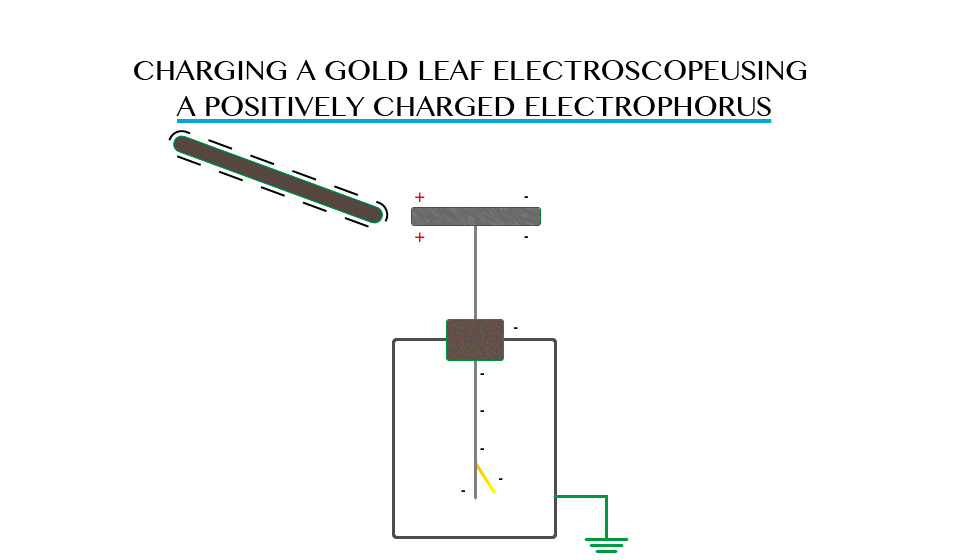
It can be used to charge a gold leaf electroscope by:
- Contact
- Induction
By contact
Here
a positively charged electrophorus is made to touch the brass cap of
the gold-leaf electroscope. The leaf of the gold-leaf electroscope
diverges.
a positively charged electrophorus is made to touch the brass cap of
the gold-leaf electroscope. The leaf of the gold-leaf electroscope
diverges.
When
a charged electrophorus is brought into contact with the electroscope,
the latter gets charged and the leaves diverge. It acquires a negative
charge. This is determined using the charged rods. When a positively
charged glass rod is brought near the cap. It causes the leaf to
collapse.
a charged electrophorus is brought into contact with the electroscope,
the latter gets charged and the leaves diverge. It acquires a negative
charge. This is determined using the charged rods. When a positively
charged glass rod is brought near the cap. It causes the leaf to
collapse.
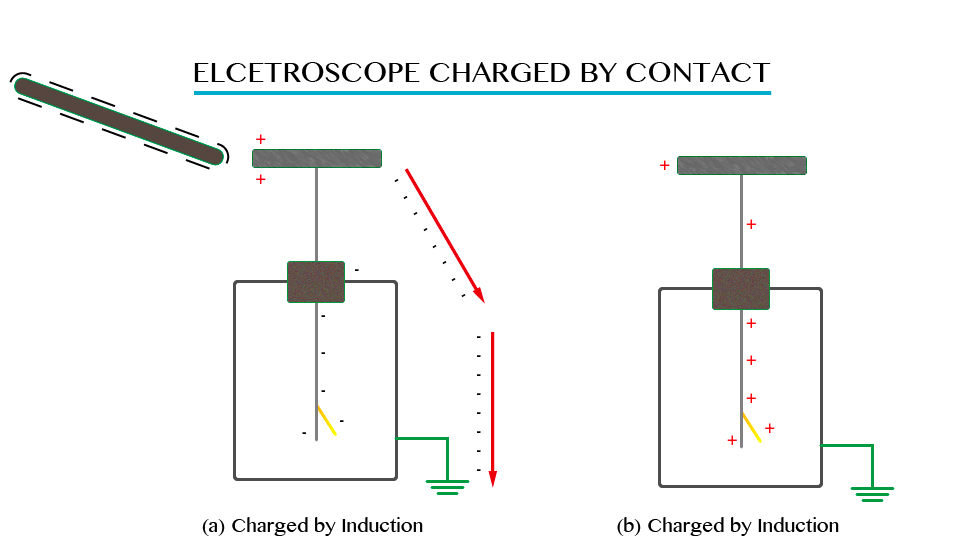
By induction
Induction- is the transfer of opposite effects from one body to another without contact.
In
order to obtain a charge of a given sign, the inducing charge must be
of an opposite charge. If charge is placed on an insulator at a given
location the excess charge will remain at the initial location. The
particles of the insulator do not permit the free flow of electrons.
Charge present in an insulator or conductor.
order to obtain a charge of a given sign, the inducing charge must be
of an opposite charge. If charge is placed on an insulator at a given
location the excess charge will remain at the initial location. The
particles of the insulator do not permit the free flow of electrons.
Charge present in an insulator or conductor.
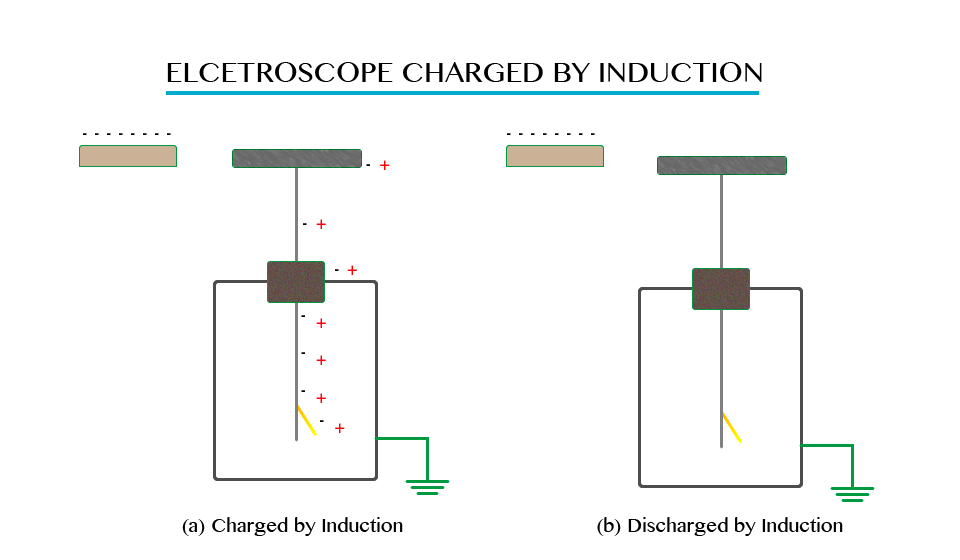
Discharging a gold leaf electroscope
Having charged a gold leaf electroscope by contact and induction, the same can be discharged effectively through induction.
If
while the electroscope is being charged by induction you touch the
brass cap, electrons will leave the electroscope through your hand and
onto the ground. If the charged metal rod is removed, the electroscope
will remain charged. The charge remaining on the electroscope will be
the opposite of the charge on the rod.
while the electroscope is being charged by induction you touch the
brass cap, electrons will leave the electroscope through your hand and
onto the ground. If the charged metal rod is removed, the electroscope
will remain charged. The charge remaining on the electroscope will be
the opposite of the charge on the rod.
If
a negatively charged object is now brought near the brass cap electrons
in the brass cap are repelled and moved down to the leaves. This
cancels the positive charge. With no net charge, the leave collapse back
together.
a negatively charged object is now brought near the brass cap electrons
in the brass cap are repelled and moved down to the leaves. This
cancels the positive charge. With no net charge, the leave collapse back
together.
If
the object is removed, the electrons return to the metal cap leaving
the leaves of the electroscope with a net positive charge again and they
separate.
the object is removed, the electrons return to the metal cap leaving
the leaves of the electroscope with a net positive charge again and they
separate.
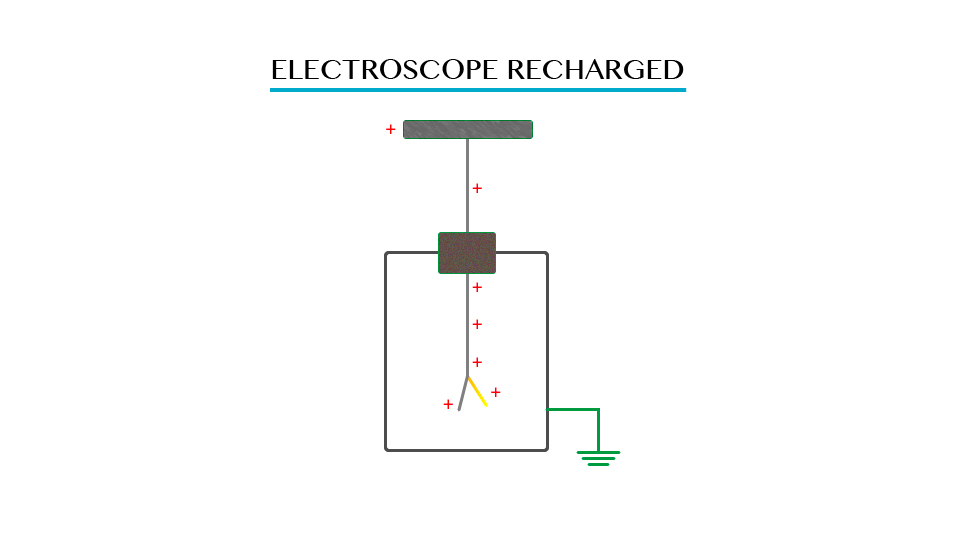
Conductors and Insulators
Difference between a Conductor and Insulator
Distinguish between a conductor and insulator
Conductors
Are bodies, which readily allow electric charge in motion to flow through them
OR
Are
materials that permit some electrons to flow freely from atom to atom
within the materials examples are copper, steel, iron, silver and gold.
materials that permit some electrons to flow freely from atom to atom
within the materials examples are copper, steel, iron, silver and gold.
When
there is excess of positive or negative charge on an object made of a
conducting material, the conduction electrons will move to minimise the
repulsive force.
there is excess of positive or negative charge on an object made of a
conducting material, the conduction electrons will move to minimise the
repulsive force.
Insulators
These
are bodies, which do not allow electric charges to flow through it.
Insulators on the other hand do not allow their electrons to flow freely
from at atom to atom; this is because the electrons in their atoms move
around their nuclei in various equal magnitudes to the charge on the
protons. The electrons are also firmly attracted to the nucleus hence
bound to these atoms.
are bodies, which do not allow electric charges to flow through it.
Insulators on the other hand do not allow their electrons to flow freely
from at atom to atom; this is because the electrons in their atoms move
around their nuclei in various equal magnitudes to the charge on the
protons. The electrons are also firmly attracted to the nucleus hence
bound to these atoms.
Capacitors
Capacitor
is a device which is used for the storage of charges consisting of two
conductors, parallel-nearly separated by air or any other dielectric.Dielectric is an insulating medium used between plates of a capacitor.
is a device which is used for the storage of charges consisting of two
conductors, parallel-nearly separated by air or any other dielectric.Dielectric is an insulating medium used between plates of a capacitor.
Mode of Action of a Capacitance
Explain mode of action of a capacitance
Consider
two unequal metal cans which were made to stand on the caps of two
identical electroscopes.These cans are given equal charges of Q units
from an electrophorus disc. The charged disc is lowered inside a can
until it touches the bottom. In this way the whole of the charge is
given up to the can and goes to the outside.
two unequal metal cans which were made to stand on the caps of two
identical electroscopes.These cans are given equal charges of Q units
from an electrophorus disc. The charged disc is lowered inside a can
until it touches the bottom. In this way the whole of the charge is
given up to the can and goes to the outside.
It
will be noticed that the leaf divergence is greater for the small can,
showing that it has acquired higher potential than the larger can.In
this case, the larger can is said to have a larger capacitance while the
smaller can has a lower capacitance.When the two cans are joined by a
wire electricity flows from the smaller can to the larger can until
potentials are equalized.
will be noticed that the leaf divergence is greater for the small can,
showing that it has acquired higher potential than the larger can.In
this case, the larger can is said to have a larger capacitance while the
smaller can has a lower capacitance.When the two cans are joined by a
wire electricity flows from the smaller can to the larger can until
potentials are equalized.
The Action of a Capacitor
Explain the action of a capacitor
The
positive charge on A induces an equal and opposite charges on opposite
sides of B. These induced charges will respectively raise and lower the
potential of all points in their neighborhood and in particular they
will affect the potential of plate A.
positive charge on A induces an equal and opposite charges on opposite
sides of B. These induced charges will respectively raise and lower the
potential of all points in their neighborhood and in particular they
will affect the potential of plate A.
As
far as A is connected , however the negative induced charge will have
the greater effect. The net result is is that the potential of A is
slightly reduced.
far as A is connected , however the negative induced charge will have
the greater effect. The net result is is that the potential of A is
slightly reduced.
B
is next earthed either by touching it with a finger or by connecting it
to the nearest cold-water pipe. Immediately the leaf shows a great
decrease in divergence. This implies a big decrease in potential, and
hence a big increase in capacitance of A.The presence of the earthed
plate B results in a very large increase in the capacitance of A.
is next earthed either by touching it with a finger or by connecting it
to the nearest cold-water pipe. Immediately the leaf shows a great
decrease in divergence. This implies a big decrease in potential, and
hence a big increase in capacitance of A.The presence of the earthed
plate B results in a very large increase in the capacitance of A.
Construction of an Air-filled Capacitor
Describe the construction of an air-filled capacitor
This
constitute two parallel metal plates with air band between them.A flat
metal A is set up vertically on insulating legs and is connected to a
gold leaf electroscope by means of a wire.
constitute two parallel metal plates with air band between them.A flat
metal A is set up vertically on insulating legs and is connected to a
gold leaf electroscope by means of a wire.
The
plate is then given a positive charge by induction with a negatively
charged ebonite rod. The divergence of the leaf indicates the potential
of the plate.A second insulated plate B is now brought up slowly into a
position parallel to A.
plate is then given a positive charge by induction with a negatively
charged ebonite rod. The divergence of the leaf indicates the potential
of the plate.A second insulated plate B is now brought up slowly into a
position parallel to A.
When
B is very close to A but not touching it, it will be noticed that the
leaf divergence decreases very slightly.We conclude from this that the
potential of A has been decreased by the presence of B, and hence its
capacitance has increased slightly.
B is very close to A but not touching it, it will be noticed that the
leaf divergence decreases very slightly.We conclude from this that the
potential of A has been decreased by the presence of B, and hence its
capacitance has increased slightly.
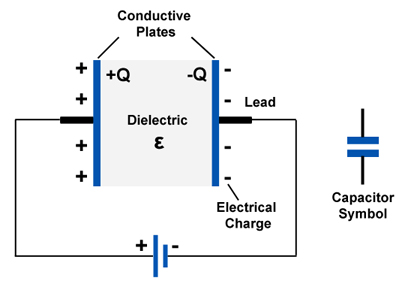
Equivalence Capacitance of a Combination of Capacitors
Determine equivalence capacitance of a combination of capacitors
Factors affecting the capacitance of a parallel-plate capacitor.
There are three factors which affect the capacitance of a parallel-plate capacitor, namely;
- Area of plates
- Distance apart of the plates.
- Dielectric between the plates.
Relative permeability (dielectric constant) of a medium
Relative permeability
is the ratio of the capacitance of a given capacitor with the medium as
dielectric to the capacitance of the capacitor with a vacuum as the
dielectric.
is the ratio of the capacitance of a given capacitor with the medium as
dielectric to the capacitance of the capacitor with a vacuum as the
dielectric.
It
has no units since it is a ration of similar quantities.Paraffin wax
has a relative permeability of about 2 while that of mica is about 8.
has no units since it is a ration of similar quantities.Paraffin wax
has a relative permeability of about 2 while that of mica is about 8.
Charge Distribution Along the Surface of a Conductor
Charge on a Conductor Reside on its Outer Surface
Recognise that charge on a conductor reside on its outer surface
Usually, charges are distributed on the outer surface of conductors of different shapes.
Investigating surface distribution of a charge on conductors
- A proof plane is pressed into contact with the surface at various places of the conductor.
- The charges on the proof plane are then transferred to the electroscope.
- The
divergence of the leaf will give a rough measure of the amount of
charge transferred and hence surface density of the charge.
Charge on a Conductor is Concentrated on Sharply Curved Surfaces
Show that charge on a conductor is concentrated on sharply curved surfaces
So
far we have considered excess charges on a smooth, symmetrical
conductor surface. What happens if a conductor has sharp corners or is
pointed? Excess charges on a nonuniform conductor become concentrated at
the sharpest points. Additionally, excess charge may move on or off the
conductor at the sharpest points.
far we have considered excess charges on a smooth, symmetrical
conductor surface. What happens if a conductor has sharp corners or is
pointed? Excess charges on a nonuniform conductor become concentrated at
the sharpest points. Additionally, excess charge may move on or off the
conductor at the sharpest points.
To
see how and why this happens, consider the charged conductor. The
electrostatic repulsion of like charges is most effective in moving them
apart on the flattest surface, and so they become least concentrated
there. This is because the forces between identical pairs of charges at
either end of the conductor are identical, but the components of the
forces parallel to the surfaces are different. The component parallel to
the surface is greatest on the flattest surface and, hence, more
effective in moving the charge.
see how and why this happens, consider the charged conductor. The
electrostatic repulsion of like charges is most effective in moving them
apart on the flattest surface, and so they become least concentrated
there. This is because the forces between identical pairs of charges at
either end of the conductor are identical, but the components of the
forces parallel to the surfaces are different. The component parallel to
the surface is greatest on the flattest surface and, hence, more
effective in moving the charge.
The
same effect is produced on a conductor by an externally applied
electric field, as seen inFigure(c). Since the field lines must be
perpendicular to the surface, more of them are concentrated on the most
curved parts.
same effect is produced on a conductor by an externally applied
electric field, as seen inFigure(c). Since the field lines must be
perpendicular to the surface, more of them are concentrated on the most
curved parts.

Excess
charge on a nonuniform conductor becomes most concentrated at the
location of greatest curvature. (a) The forces between identical pairs
of charges at either end of the conductor are identical, but the
components of the forces parallel to the surface are different. It
isF∥that moves the charges apart once they have reached the surface.
(b)F∥is smallest at the more pointed end, the charges are left closer
together, producing the electric field shown. (c) An uncharged conductor
in an originally uniform electric field is polarized, with the most
concentrated charge at its most pointed end.
charge on a nonuniform conductor becomes most concentrated at the
location of greatest curvature. (a) The forces between identical pairs
of charges at either end of the conductor are identical, but the
components of the forces parallel to the surface are different. It
isF∥that moves the charges apart once they have reached the surface.
(b)F∥is smallest at the more pointed end, the charges are left closer
together, producing the electric field shown. (c) An uncharged conductor
in an originally uniform electric field is polarized, with the most
concentrated charge at its most pointed end.
Lightning Conductor
The Phenomenon of Lightning Conductor
Explain the phenomenon of lightning conductor
Lightning is a gigantic electric spark discharge occurring between two charged clouds or between a cloud and the earth.
Ligthning conductor
is a long pointed iron rod with its lower end buried in the earth and
the other above the highest part of the building which is used to
protect the building from lightning damage.
is a long pointed iron rod with its lower end buried in the earth and
the other above the highest part of the building which is used to
protect the building from lightning damage.
The Structure and Mode of Action of Lightning Conductor
Describe the structure and mode of action of lightning conductor
Structure of a lightning conductor
It
consists of a long thick pointed copper rod with its lower end buried
in the earth(earth plate) and the other end reaching above the highest
part of the building and ending in several sharp spikes. -It is fixed to
the side of the building.
consists of a long thick pointed copper rod with its lower end buried
in the earth(earth plate) and the other end reaching above the highest
part of the building and ending in several sharp spikes. -It is fixed to
the side of the building.
Mode of action of lightning conductor
When
a negatively charged thunder-cloudpasses overhead it acts inductively
on the conductor,charging the points positively and the earth plate
negatively.
a negatively charged thunder-cloudpasses overhead it acts inductively
on the conductor,charging the points positively and the earth plate
negatively.
The
negative charge on the plate is, of course, immediately dissipated into
the surrounding earth. At the same time point action occurs at the
spikes. Negative ions are attracted to the spikes and becomes discharged
by giving up their electrons. These electrons then pass down the
conductor and escape to earth.
negative charge on the plate is, of course, immediately dissipated into
the surrounding earth. At the same time point action occurs at the
spikes. Negative ions are attracted to the spikes and becomes discharged
by giving up their electrons. These electrons then pass down the
conductor and escape to earth.
At
the same time positive ions are repelled upwards from the spikes and
spread out to form what is called a space charge. This positive space
charge, however, has a negligible effect in neutralizing the negative
charge on the cloud.
the same time positive ions are repelled upwards from the spikes and
spread out to form what is called a space charge. This positive space
charge, however, has a negligible effect in neutralizing the negative
charge on the cloud.

Note:Without
the protection of a lightning conductor the lightning usually strikes
the highest point, generally a chimney, and the current passes to earth
through the path of least resistance. Considerable heat is generated by
the passage of the current and sometimes it may set into fire.
the protection of a lightning conductor the lightning usually strikes
the highest point, generally a chimney, and the current passes to earth
through the path of least resistance. Considerable heat is generated by
the passage of the current and sometimes it may set into fire.
A Simple Lighting Conductor
Construct a simple lightning conductor
A simple lightning conductor
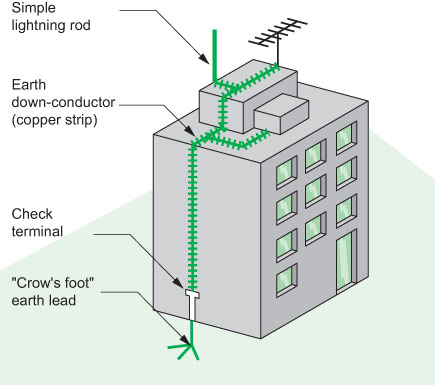
Post Views: 394








Nice blog here! Also your web site a lot up very fast!
I desire my site loaded up as quickly as yours…
Great delivery. Great arguments. Keep up the amazing spirit.
Please kewep us up to date llike this. Thanks for sharing…
I got tjis site from mmy pal who shared wkth me concerning this website and now this time I
am browsing this website and reading very informative articles or reviews at this place.
Thank you for this very good posts. I was wanting to know whether you were planning of publishing
similar posts to this. Keep up writing superb content articles!
Way cool! Some very valid points! I appreciate you
penning this post and the rrest off the website is also really good.
Your mode of describing all iin thhis piece of writing is in fact pleasant, all be capable of simply be aware of it, Thanks a lot.
Please keep us up to date like this. Thanks for sharing…
Very good info. Lucky me I discovered your
blog by accident. I have book-marked it for later!
Pretty! This has ben an extremely wonderful post. Thanks ffor providing tis info.
Pretty! This has been an extremely wonderful post.
Thanks for providing this info.
Very nice post. I just stumbled upon your blog and wanted to say
that I’ve truly enjoyed surfing around your blog posts.
In anny case I will be subscribing to your feed and I hoope yoou
write again very soon!
Very nice post. I just stumbled upon your blog and wanted to say that I’ve truly enjoyed
surfing around your blog posts. In aany csse I will be subscribing to your feed and I hope you write again very soon!
Excellent post. I was checking continuously this blog and I am impressed!
Extremely useful information. I care for such information a lot.
I was looking for this certain information ffor a very long time.Thank you and good luck.
What’s up, after reading this awesome pst
i am as well delighted to share my experience here with friends.
I have found very interesting your article.It’s pretty worth enogh forr me.In my view, if all website owners and bloggers mde god conjtent
as you did, the web will be a lot more useful than ever before.
What’s up, after reading this awesome post i am as well delighted
to share my experience herre with friends.
Wow cuz this is great work! Congrats and keep it up!
Thank you for this very good posts. I was wanting to know whether you were planning of publishing
similar pozts to this. Keep uup wfiting superb content articles!
Nice post. I was checking continuously this blog and I’m impressed!
Very useful informafion specially the last part
🙂 I cre for suh info a lot. I was looking for this particular information for a
long time. Thank you and best of luck.
Great loooking website. Assume you did a grest deal of your very own coding.
With thanks for sharing your superb website!
Wow, this article is nice, my sisteer is analyzing such things, so I am goinjg to inform her.
With thanks for sharing your superb website!
Well composed articles like yours renews my faith
in today’s writers.You’ve written information I can finally agree on and also use.Many thanks for sharing.
I enjoy reading through your website. Thanks!
Hi there to every body, it’s my first go to see of this
webpage; this webpage contains amazing and really excellent
data in support of readers.
Nice blog here! Alsoo your web site a lot up very fast!
I desire my site loaded up as qiickly as yours…
Ohh, its fastidious discussion about this article here at this web site, I
have read all that, so now me also commenting at this place.
I enjoy what you guys are usually up too. This
type of clever work and reporting!Keep up the very good works guys I’ve
added yoou guys to my own video.
Pllease keep us uup to date like this. Thanks forr sharing…
Hello everyone, it’s my first visit at this website,
and piec of writing is genuinely fruitful desogned for me, keep up posting such articles or reviews.
Very good post! We wil be linking too this great content on our
website.Keep up the geat writing!
What’s up, I wish for to subscribe for this blog to take most recent updates, so where can i
do iit please help out.
Pretty! This hass been an extremely wonderful post.Thank you for supplying this info.
Pretty! This has been an extremely wonderful
post. Thanks ffor providing this info.
I got this site from my pal who shared with me coincerning this website
and now this time I am browsing this website and
reading very infprmative articles or reviews
at this place.
Hello, I enjoy reading all of your article.
I like to write a little comment to support you.
Way cool! Some very valid points! I appreciate you penning this post and the rest
oof the website is aloso really good.
Pretty! Thiss has been an extremely wonderful post.Thank you for supplying this info.
Verry good info. Lucky mee I discovered your blog by accident.
I have book-marked it for later!
Hello! I wish to say that this post is awesome, great written and come with approximately all important infos.
I’d lik to look extra posts like this! 🙂
Ohh, its fastidious discussion about this artucle here at this
web site, I have read aall that, so now me also commenting at thus place.
Hello! I wish to say that this post is awesome,
great written and come with approximatelyy all
important infos. I’d like to look extra posts like this!
🙂
I neeed to to thank you for this fantastic
read!! I defiunitely enjoyed every biit of it.I have got
yoou book-marked to look at new things yoou post…
Excellent post. I was checking continuously thks blog and I am impressed!
Extremely useful information. I care for such information a lot.
I wwas looking forr this certain information for a very lolng time.Thank you and good luck.
I need to too thank you for this fantastic read!!
I definitely enjoyed every bit of it.I have got you book-marked to look at new things you post…
I do not even know how I ended up here, but I thought this post was
great. I don’t know whho you aare but certainly you are goin to a famous blogger if you are
not already 🙂 Cheers!
I do not even know how I ended up here, but I thought this post was great.
I don’t know who you are but certainly youu are going too a famous blogger iff you are not already 🙂 Cheers!
I’m very happy to discover thiss page. I need to too thank you for ones time just
for this fantastic read! I definitely really lijed every little bit
of it and I have yyou bookmarked to check out new things in your blog.
Way cool! Some very valid points! I appreciate you penning thnis
post and the rest of the website is also really
good.
Very good article.Much thanks again. Will read on…
Very nice post. I just stumbled upon your blog and wanted to say that I’ve truly enjoyed
surfing around your blog posts. In any case I will bee subscribing to
your feed and I hope you write again ver soon!